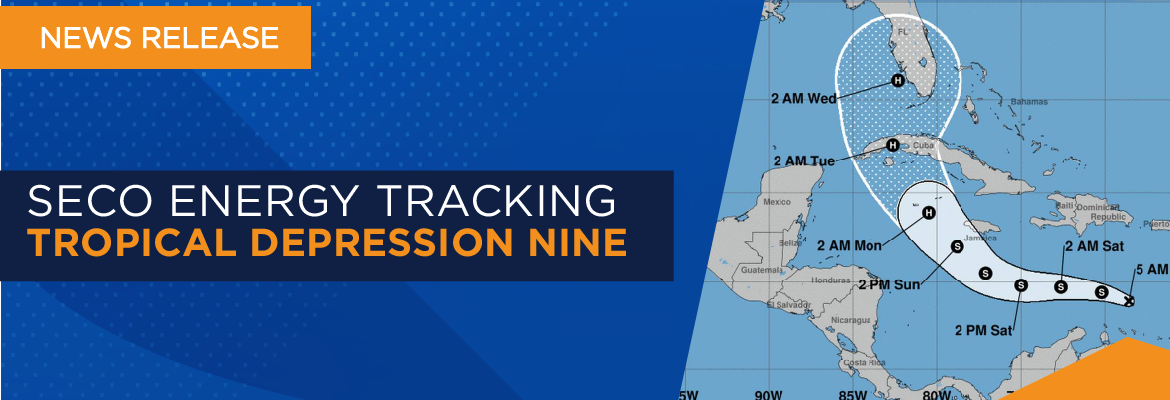SECO Energy Tracking Tropical Depression Nine
SECO Energy is tracking Tropical Depression Nine as it slowly moves on a westerly track toward the Florida Peninsula. Tropical Depression Nine (TD9) is expected to strengthen to a hurricane this weekend. The storm would be renamed Hurricane Hermine and could impact Central Florida as a Category 2 hurricane early next week.
TD9 was formerly known as Invest 98L. Meteorologists have watched the storm as it became more organized this week. TD9 is moving west-northwest at 13 mph with maximum sustained wind speeds of 35 mph. The latest National Hurricane Center (NHC) forecast puts the storm in the Gulf of Mexico and moving across Central Florida early next week. TD9 is still far away from Florida, and models will continue to shift this weekend.
SECO Energy’s service territory could begin to feel the effects of Tropical Depression Nine as it strengthens into a Category 2 hurricane as early as Tuesday of next week. Category 2 hurricanes have maximum sustained wind speeds between 96 and 110 mph. If the storm arrives in SECO’s service area, members will experience widespread heavy rains and gusty winds. A soggy August and early September storms have left standing water in some areas. Additional rain and high winds can cause downed trees and power outages for members.
CEO Curtis Wynn assured members that SECO Energy is StormReady and ready to respond to power outages caused by tropical storms and hurricanes. Wynn stated, “SECO Energy is tracking Tropical Depression Nine and the possible weather effects that this system could bring to SECO’s service area. We are StormReady and prepared to respond to outages caused by tropical storms and hurricanes. I am asking members to prepare for the possibility that Tropical Depression Nine will strengthen and move toward our service territory. Now is the time to gather essential hurricane supplies. While we are nearing the end of Atlantic hurricane season and Tropical Depression Nine’s ultimate track remains uncertain, this reminds us to stay vigilant for late season storms.”
StormCenter is SECO Energy’s outage and communications platform for members to report outages, check the status of an existing outage and enroll in outage communications and alerts via email, text, voice or all three. Visit StormCenter today and bookmark on your smartphone or tablet to report outages quickly and easily.
Major weather events can cause extended power outages. SECO Energy reminds members to follow safety protocols when using a generator during a power outage. Generators emit deadly carbon monoxide (CO) that is odorless and colorless. Thousands of people die each year from CO poisoning. Never operate a generator in an enclosed space, including a garage. Always place the generator at least 15 to 20 feet away from your home and never near open windows.
Before operating a generator, thoroughly read and review the owner’s manual. Never plug a generator directly into an electrical outlet. This current flow is deadly for utility personnel. Keep children away from an operating generator and store fuel in approved containers. Do not smoke while fueling a generator. Always operate a generator in a dry space. If it is raining, use a canopy or cover. SECO Energy’s Hurricane Handbook includes generator safety tips and how to prepare for before, during and after a storm.
“Like” SECO Energy on Facebook and follow @SECOEnergy on Twitter for prize drawings, news releases, and severe weather alerts affecting SECO Energy’s service territory. Manage your outage notification preferences at StormCenter. To see when SECO Energy crews/contractors are working in your area, visit our new System Improvement map. To learn more about SECO Energy as a not-for-profit cooperative, visit SECOEnergy.com>Your Co-op>About.




